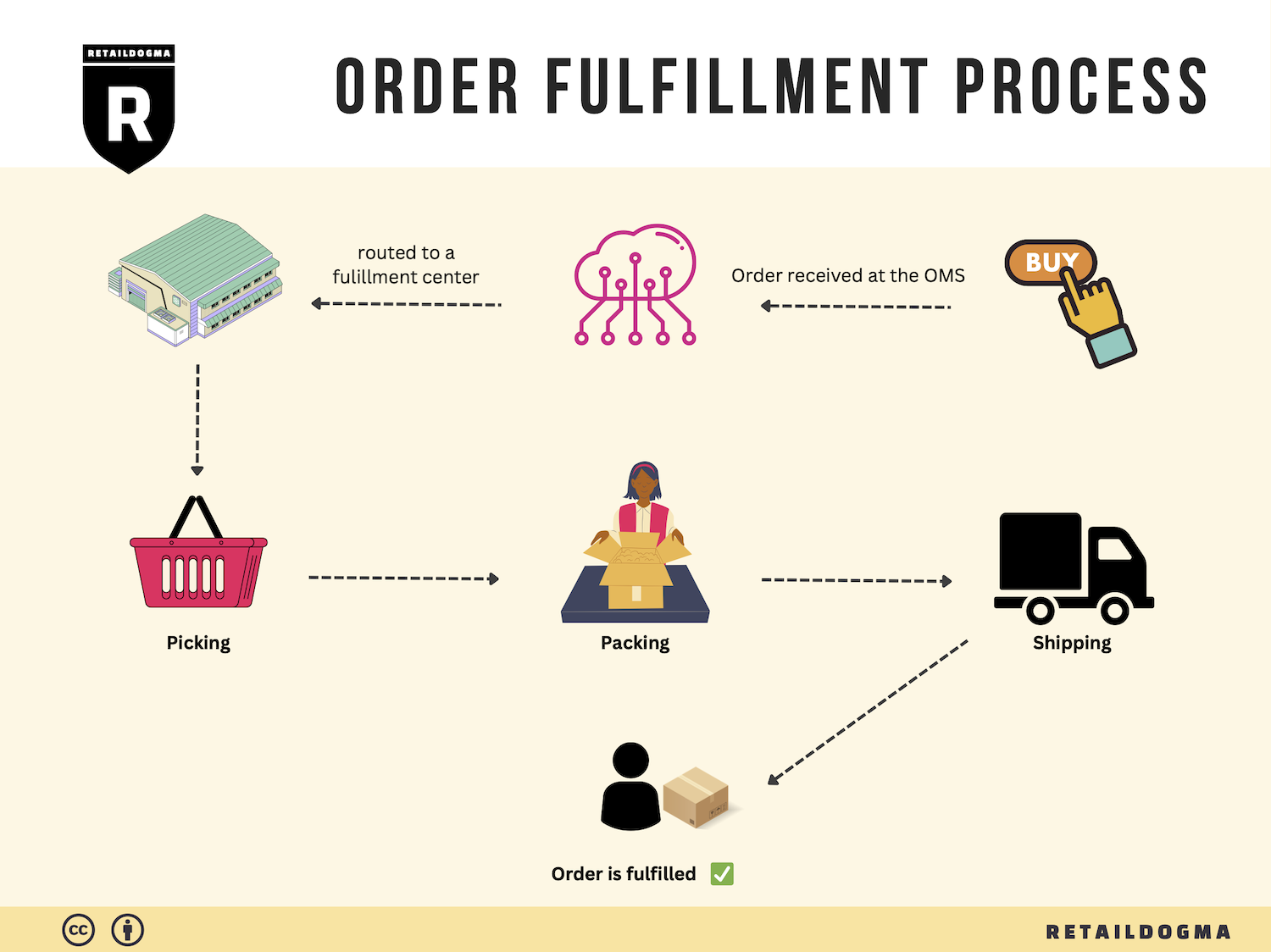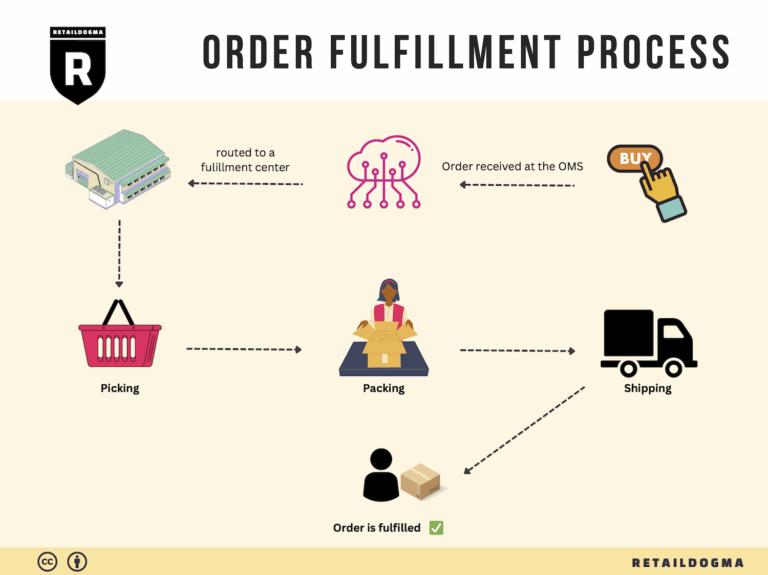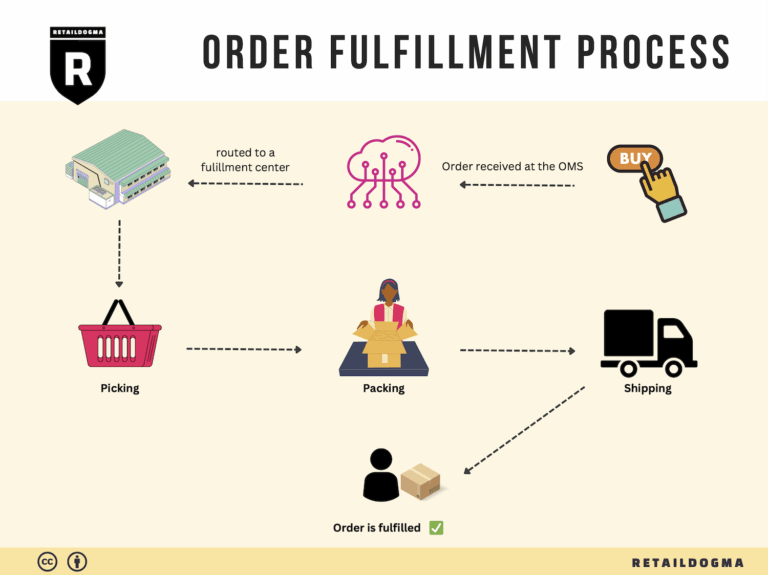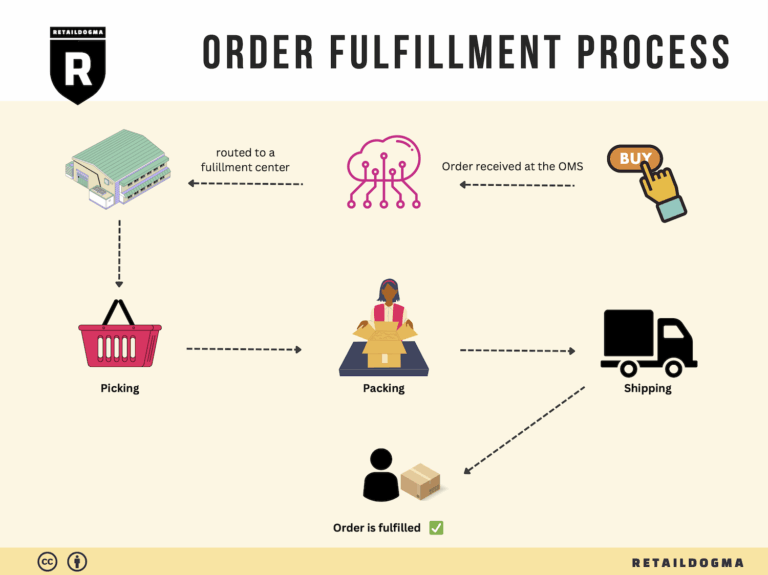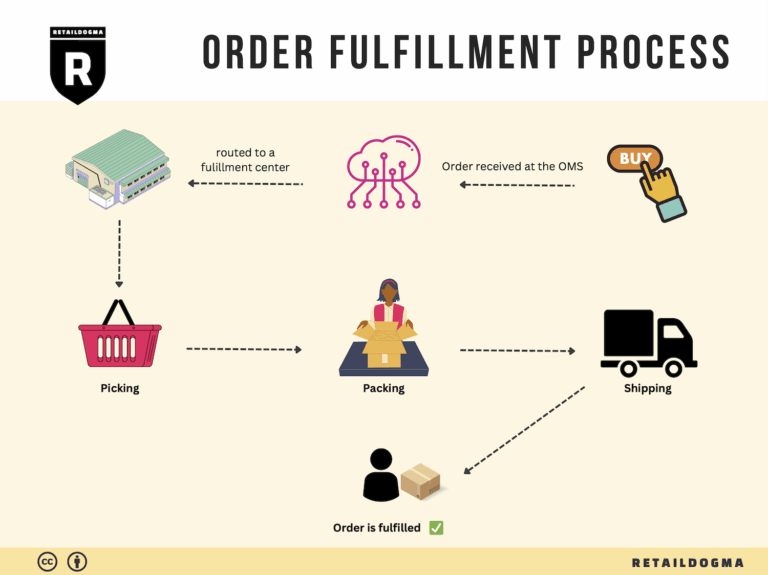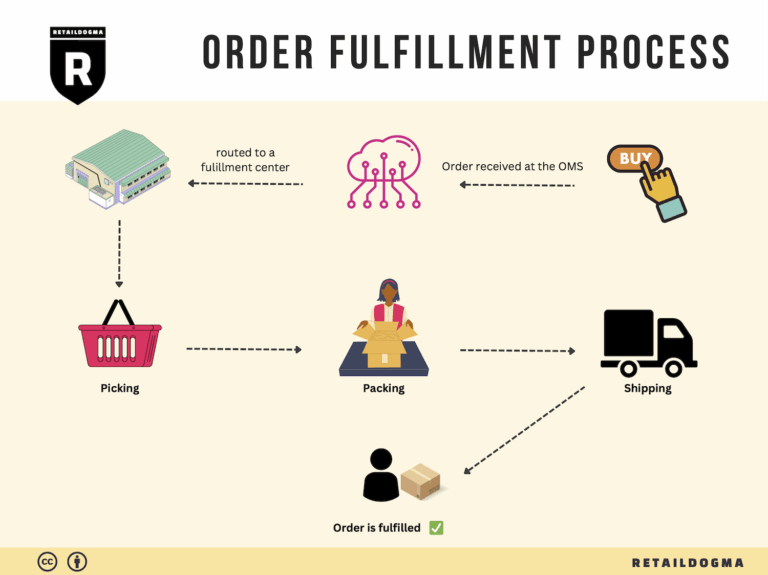What Is A Fulfillment Center? A Complete Guide (2025)
What is E-commerce Fulfillment? An Introduction for Growing Businesses
Understanding E-commerce Fulfillment
For many growing e-commerce businesses, the excitement of increasing sales often comes hand-in-hand with the daunting challenge of managing orders effectively. As your customer base expands, so does the complexity of packing and shipping orders. This overwhelming task can quickly become a bottleneck, hindering growth and diminishing the customer experience. That’s where e-commerce fulfillment comes into play.
At its core, fulfillment is the process of getting a product from your inventory into the hands of your customer. It encompasses everything from receiving orders to picking, packing, and shipping items, as well as managing returns. As the backbone of your logistics operations, effective fulfillment can significantly enhance your operational efficiency and customer satisfaction.
This guide is designed to demystify the world of e-commerce fulfillment for business owners, operations managers, and entrepreneurs looking to scale their logistics processes. Here’s what you can expect to find:
-
Different Fulfillment Models: We’ll explore various fulfillment models, including Third-Party Logistics (3PL) and Fulfillment by Amazon (FBA). Each model has its unique advantages and challenges, and understanding these can help you choose the right fit for your business needs.
-
Core Fulfillment Services: We will outline the essential services involved in the fulfillment process, such as inventory management, order processing, packing, shipping, and returns handling. Knowing what services are available can aid in streamlining your operations.
-
Choosing the Right Fulfillment Partner: Selecting a fulfillment partner is a critical decision that can impact your business’s efficiency and customer experience. We will discuss key considerations to evaluate when choosing a partner, such as reliability, technology integration, and scalability.
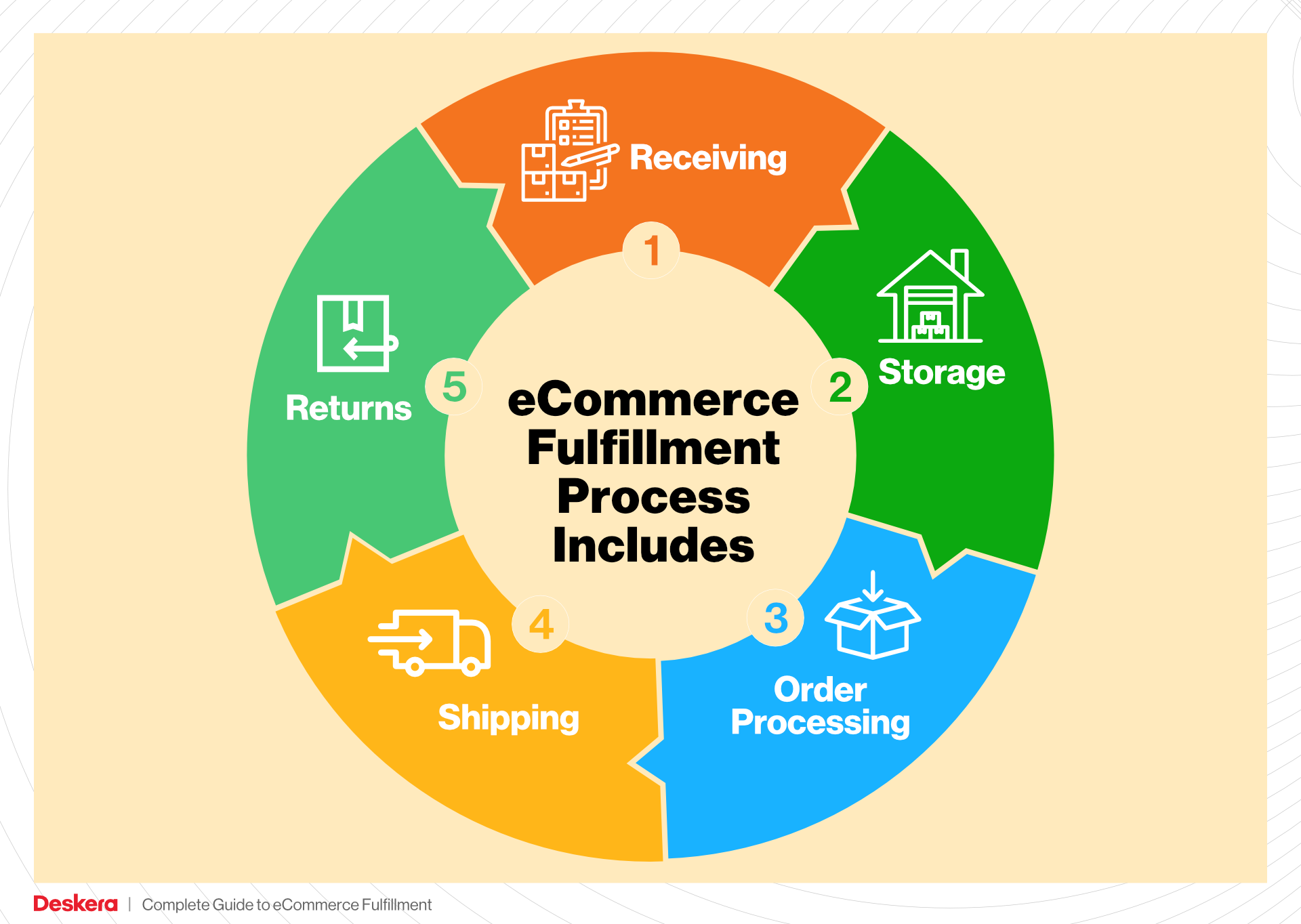
-
Pricing Structures: Understanding the pricing models for fulfillment services is crucial for managing your budget. We will break down common pricing strategies and what factors can influence costs.
The ultimate goal of this guide is to empower you to make informed decisions about your logistics strategy. By understanding the intricacies of e-commerce fulfillment, you can enhance your operational capabilities, improve customer satisfaction, and ultimately drive your business growth. Let’s dive in and unravel the complexities of fulfillment together!
What You’ll Learn In This Guide
- What is E-commerce Fulfillment? An Introduction for Growing Businesses
- The Order Fulfillment Process: From ‘Buy’ Button to Customer’s Door
- Comparing Fulfillment Models: In-House vs. 3PL vs. Dropshipping
- A Deep Dive into Amazon FBA: Pros, Cons, and Who It’s For
- Core Services Offered by Fulfillment Centers
- How to Choose a Fulfillment Partner: A 6-Point Checklist
- Understanding Fulfillment Pricing: A Breakdown of Common Fees
- Frequently Asked Questions (FAQs) about Fulfillment
- Conclusion: Is Outsourcing Fulfillment the Right Move for Your Business?
- Important Disclaimer
The Order Fulfillment Process: From ‘Buy’ Button to Customer’s Door
1. Receiving Inventory
The first step in the order fulfillment process is receiving inventory. This phase involves the delivery of products from suppliers to your warehouse or retail location. Upon arrival, a thorough inspection is conducted to ensure that the shipment matches the purchase order in terms of quantity and quality. Each item is assigned a Stock Keeping Unit (SKU), a unique identifier that helps track inventory levels and streamline management.
Importance: Efficient receiving processes are vital for maintaining accurate inventory records and minimizing discrepancies. If an order is short or contains damaged goods, it can lead to delays in fulfilling customer orders, resulting in dissatisfaction and potential loss of future sales.
2. Warehouse Storage
Once the inventory is received and verified, it moves to the warehouse storage phase. Here, products are strategically organized based on factors such as size, weight, and demand frequency. Utilizing inventory management systems, businesses can assign specific locations for each SKU, facilitating easy retrieval.
Importance: Proper storage solutions enhance efficiency by reducing the time employees spend locating items. Effective organization not only speeds up the picking process but also minimizes the risk of stockouts and overstock situations. This step is critical for maintaining a balanced supply chain and ensuring that products are readily available to meet customer demand.
3. Order Picking
The order picking stage is where the actual fulfillment of customer orders begins. When a customer places an order, the fulfillment team generates a pick list—a document or digital interface that outlines the items required to fulfill that order. Employees then navigate the warehouse to collect the specified products.
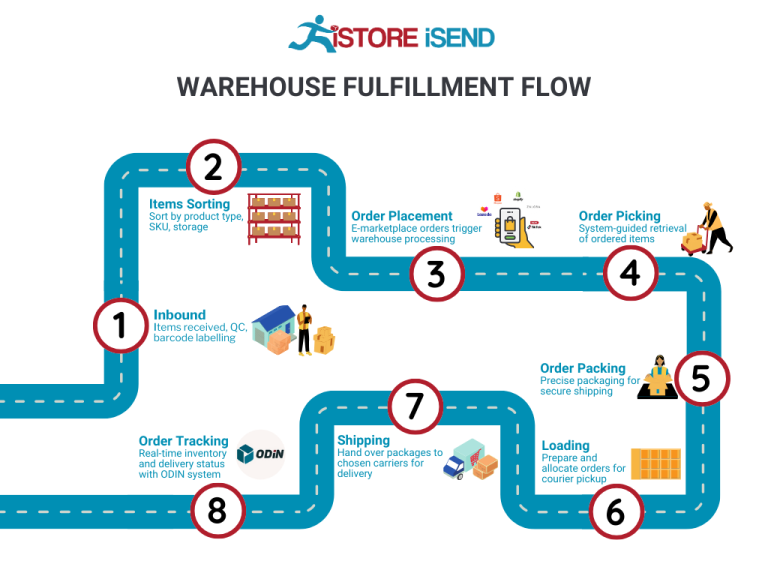
Importance: Accuracy in order picking is essential for customer satisfaction. Errors at this stage can lead to incorrect shipments, resulting in returns and exchanges that disrupt operations. Implementing barcode scanning technology can enhance accuracy, allowing for quick verification of items as they are picked.
4. Order Packing
After the items have been picked, they are brought to the packing area. Here, products are prepared for shipment. The packing process involves selecting appropriate packaging materials to protect the items during transit. Additionally, packing slips are included, detailing the contents of the shipment and any relevant return information.
Importance: Effective packing safeguards products against damage during shipping and ensures that customers receive their orders in excellent condition. It also plays a role in branding; well-packaged items enhance the overall customer experience and can encourage repeat business. Utilizing packing automation tools can also streamline this process, reducing labor costs and increasing efficiency.
5. Shipping & Delivery
The final step in the order fulfillment process is shipping and delivery. Once the order is packed, it is labeled and dispatched to the carrier for transport. Businesses must choose reliable shipping partners to ensure timely delivery. Tracking systems are essential at this stage, allowing both the business and the customer to monitor the shipment’s progress.
Importance: Timely delivery is a crucial factor influencing customer satisfaction and loyalty. An efficient shipping process can differentiate your business in a competitive market. Moreover, offering multiple shipping options, such as express or standard, can cater to diverse customer preferences, enhancing the overall shopping experience.
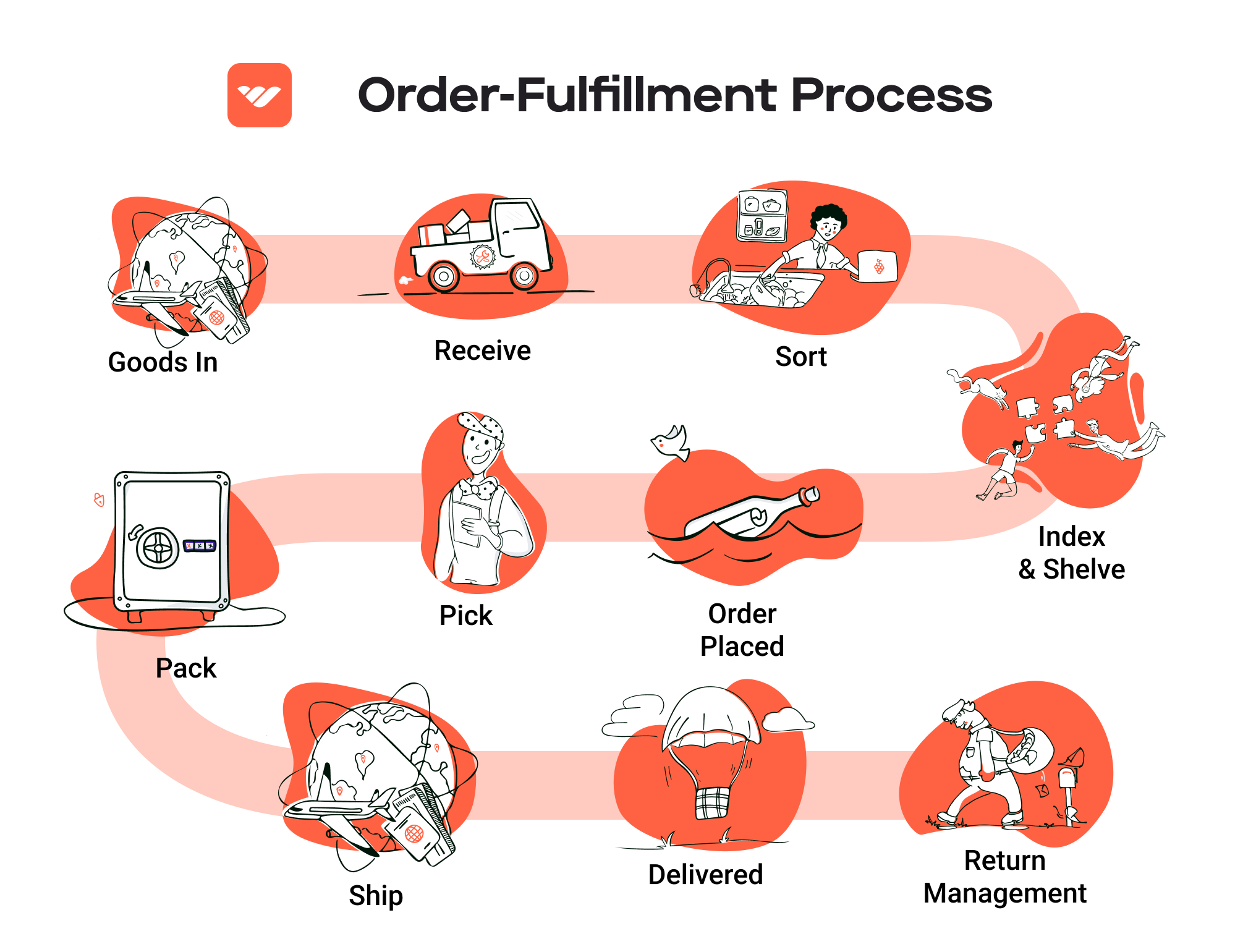
In summary, understanding and optimizing each step of the order fulfillment process—from receiving inventory to shipping and delivery—can significantly enhance operational efficiency and customer satisfaction. By focusing on accuracy, organization, and timely execution, e-commerce businesses can scale effectively and build lasting relationships with their customers.
Comparing Fulfillment Models: In-House vs. 3PL vs. Dropshipping
Comparison of Fulfillment Models
| Model | Who Handles Inventory | Best For (Business Stage) | Key Advantage | Key Disadvantage |
|---|---|---|---|---|
| In-House Fulfillment | The business itself | Established businesses | Complete control over operations | High overhead costs and labor demands |
| Third-Party Logistics (3PL) | A third-party provider | Growing businesses | Scalability and reduced overhead | Less control over inventory and quality |
| Dropshipping | Supplier | Startups and small businesses | Low upfront investment and risk | Lower profit margins and potential stock issues |
In-House Fulfillment
In-house fulfillment refers to a model where the business manages its own inventory and logistics operations. This approach is ideal for established businesses that have sufficient resources and a stable customer base. By handling all aspects of order fulfillment internally, businesses can maintain complete control over their operations. This includes managing inventory levels, quality control, and shipping processes. The key advantage of in-house fulfillment is the ability to create a tailored customer experience, as businesses can fine-tune their logistics processes to meet specific customer needs and preferences. However, this model comes with significant overhead costs, including warehousing, staffing, and technology investments. Moreover, as order volumes increase, businesses may struggle to scale operations efficiently, leading to potential fulfillment delays or errors.
Third-Party Logistics (3PL)
Third-party logistics (3PL) involves outsourcing fulfillment operations to a specialized logistics provider. This model is particularly beneficial for growing businesses that need to scale their operations without the burden of managing inventory directly. 3PL providers offer a range of services, including warehousing, order processing, and shipping, allowing businesses to focus on core activities such as marketing and product development. The primary advantage of using a 3PL is the scalability it offers; businesses can easily adjust their logistics capacity in response to changing demand without incurring the fixed costs associated with in-house fulfillment. However, outsourcing fulfillment can lead to a loss of control over inventory and quality, which may affect customer satisfaction if not properly managed. Additionally, businesses may face challenges in establishing strong communication and coordination with the 3PL provider.
Dropshipping
Dropshipping is a fulfillment model where the retailer does not hold inventory but instead transfers customer orders directly to a supplier, who then ships the products to the customer. This model is especially popular among startups and small businesses due to its low upfront investment and minimal risk. Since retailers do not have to invest in inventory upfront, they can offer a wide range of products without the financial burden of maintaining stock. The key advantage of dropshipping is the ability to test new products and markets quickly without significant financial exposure. However, the dropshipping model comes with its own set of challenges. Retailers often face lower profit margins due to reliance on suppliers and may encounter issues such as stock shortages or shipping delays, which can negatively impact customer satisfaction. Furthermore, the lack of control over inventory and fulfillment processes can make it challenging to manage quality and delivery expectations.
In summary, each fulfillment model offers distinct advantages and disadvantages, making it crucial for e-commerce businesses to carefully consider their current stage, resources, and growth plans when selecting the best fulfillment strategy. By understanding the nuances of in-house fulfillment, 3PL, and dropshipping, business owners can make informed decisions that align with their operational goals and customer expectations.
A Deep Dive into Amazon FBA: Pros, Cons, and Who It’s For
Understanding Fulfillment by Amazon (FBA)
Fulfillment by Amazon (FBA) is a service that allows e-commerce businesses to outsource their logistics and order fulfillment to Amazon. With FBA, sellers send their products to Amazon’s fulfillment centers, where Amazon takes care of storage, packaging, and shipping directly to customers. This service enables sellers to leverage Amazon’s vast logistics network, thereby simplifying the complexities associated with order fulfillment.
When a customer orders a product listed under FBA, Amazon handles everything from inventory management to customer service, including returns. This can free up valuable time and resources for sellers, allowing them to focus on scaling their business.
How FBA Works
-
Product Listing: Sellers create product listings on Amazon and select FBA as their fulfillment method.
-
Shipping Inventory: Sellers ship their products to Amazon’s fulfillment centers. Amazon provides guidelines on how to package and label products for efficient storage and retrieval.
-
Storage: Once received, products are stored in Amazon’s warehouses. Amazon manages the inventory and ensures that it is organized for quick access.
-
Order Processing: When a customer places an order, Amazon picks, packs, and ships the product.
-
Customer Service and Returns: Amazon handles all customer inquiries and manages returns, providing a seamless experience for both sellers and customers.
Pros of FBA
1. Prime Eligibility
One of the most significant advantages of using FBA is that products become eligible for Amazon Prime. This means that Prime members can receive free two-day shipping on FBA products, making them more attractive to a large segment of customers. Prime membership is a powerful motivator for purchase, and being part of this program can significantly increase sales.
2. Customer Trust
Amazon has built a strong reputation for customer service and reliability. By using FBA, sellers benefit from this trust. Customers are more likely to purchase items that are fulfilled by Amazon due to their established policies on returns and refunds. This can lead to higher conversion rates and improved customer satisfaction.
3. Multi-Channel Fulfillment
FBA can also serve as a multi-channel fulfillment solution. Sellers can use Amazon’s logistics to fulfill orders from their own websites or other marketplaces. This centralizes inventory management and streamlines operations, allowing sellers to take advantage of Amazon’s efficient shipping processes while selling on various platforms.
4. Time Savings
Outsourcing fulfillment to Amazon can save sellers significant time and effort. With Amazon managing storage, packing, shipping, and customer service, sellers can focus on other critical aspects of their business, such as marketing and product development.
5. Scalability
FBA allows businesses to scale quickly without the need for investing heavily in their logistics infrastructure. As demand for products increases, sellers can simply send more inventory to Amazon’s fulfillment centers, allowing them to meet customer demand without significant overhead costs.
Cons of FBA
1. High Fees
While FBA can offer significant benefits, it also comes with high fees. These include storage fees (charged monthly based on the amount of space your products occupy) and fulfillment fees (charged per unit sold). For some sellers, especially those with low-margin products, these fees can significantly cut into profits.
2. Strict Inventory Rules
Amazon has specific guidelines regarding inventory management, including strict policies on inventory limits and performance metrics. Sellers must constantly monitor their inventory levels to avoid incurring extra fees for long-term storage or having their listings suppressed due to poor performance.
3. Commingling Risks
FBA often involves commingling inventory, which means that products from different sellers may be stored together. While this can streamline the shipping process, it also presents risks. If a customer receives a damaged or counterfeit product, it can reflect poorly on the seller, even if the issue was due to another seller’s inventory.
4. Limited Control Over Fulfillment
Sellers relinquish some control over the fulfillment process when using FBA. They cannot customize packaging or delivery options as they could if they were handling fulfillment in-house. This may be a disadvantage for brands that wish to maintain a unique customer experience.
5. Complexity in Returns
While Amazon handles returns, this can sometimes lead to confusion. Sellers may find it challenging to manage returned items effectively, especially if they need to assess the condition of returned products before restocking them.
Who is FBA Best For?
Fulfillment by Amazon is particularly advantageous for e-commerce businesses that are looking to scale quickly and efficiently without investing heavily in logistics infrastructure. It is ideal for:
- Small to Medium-Sized Sellers: Businesses that lack the resources to manage their own fulfillment operations can benefit from FBA’s comprehensive services.
- Brands Seeking National Reach: Sellers wanting to expand their market presence across the U.S. can leverage Amazon’s logistics network to reach customers faster and more reliably.
- Product Categories with High Demand: Sellers of high-volume products, especially in categories like electronics, home goods, and seasonal items, can maximize their sales potential through Prime eligibility and customer trust.
- Entrepreneurs Focused on Growth: For those looking to grow their business without getting bogged down in logistics, FBA allows them to concentrate on core business functions while Amazon takes care of fulfillment.
In conclusion, while FBA offers numerous advantages that can facilitate growth and efficiency, it’s essential for e-commerce businesses to carefully evaluate the associated costs and risks. By understanding these dynamics, sellers can make informed decisions about whether FBA aligns with their business goals.
Core Services Offered by Fulfillment Centers
Inventory Management & Warehousing
Inventory management and warehousing are foundational services provided by fulfillment centers that ensure e-commerce businesses can effectively track and store their products. Fulfillment centers utilize sophisticated inventory management systems that offer real-time tracking of stock levels, enabling businesses to maintain optimal inventory levels while reducing the risks of stockouts or overstock situations.
The benefits of effective inventory management include improved cash flow, as businesses can better align their purchasing with actual sales data. Furthermore, an efficient warehousing system allows for the organization of products in a way that streamlines order processing, reducing the time it takes to pick items for shipment. This not only enhances operational efficiency but also improves customer satisfaction by ensuring timely deliveries.
By leveraging advanced analytics, fulfillment centers can also provide insights into inventory turnover rates and trends, allowing e-commerce businesses to make informed decisions regarding product offerings and seasonal adjustments. This data-driven approach supports strategic planning, enabling businesses to adapt quickly to market changes and customer preferences.
Pick and Pack Services
Pick and pack services are critical in the fulfillment process, involving the selection of ordered items from inventory and preparing them for shipment. Fulfillment centers employ trained personnel and automated systems to efficiently pick items, ensuring accuracy and speed. The packing process is equally crucial; it involves securely packaging products to minimize damage during transit while adhering to branding guidelines.
The primary benefit of pick and pack services is the significant reduction in order processing time. With a dedicated team focused on these tasks, e-commerce businesses can fulfill a higher volume of orders in a shorter timeframe, thus enhancing customer experience and loyalty. Additionally, accurate picking and packing reduce the likelihood of errors, which can lead to costly returns and customer dissatisfaction.
Furthermore, fulfillment centers often offer customizable packing options, such as branded boxes or inserts, which help reinforce brand identity and create a positive unboxing experience for customers. This attention to detail not only boosts customer satisfaction but can also lead to increased repeat purchases and customer referrals.
Kitting and Assembly
Kitting and assembly services involve grouping individual items into ready-to-ship sets or kits, often enhancing the product offering for customers. This service is particularly beneficial for businesses that sell complementary products or promotional bundles, as it allows for streamlined operations and improved inventory management.
The benefit of kitting and assembly is multifaceted. First, it simplifies the ordering process for customers by offering them a complete solution rather than requiring them to purchase items separately. This can increase the average order value and encourage customers to make larger purchases. Second, by pre-assembling products, fulfillment centers can significantly reduce the time required to fulfill orders, thereby improving overall efficiency.
Additionally, kitting can help businesses manage seasonal promotions or limited-time offers effectively. By preparing kits in advance, fulfillment centers can quickly respond to demand spikes, ensuring that popular items remain available and reducing the risk of lost sales due to stockouts.
Returns Management (Reverse Logistics)
Returns management, or reverse logistics, is an essential service offered by fulfillment centers that focuses on processing returns efficiently and effectively. In the e-commerce landscape, where return rates can be significantly higher than in traditional retail, a robust returns management system is vital for maintaining customer satisfaction and loyalty.
The primary benefit of effective returns management is the ability to process returns quickly, which can help mitigate the negative impacts of returns on a business’s cash flow and inventory levels. Fulfillment centers can inspect returned items, restock sellable products, and manage the disposition of unsellable items, ensuring that businesses retain as much value as possible from returned merchandise.
Moreover, a streamlined returns process enhances customer experience. Offering easy returns can be a significant selling point for e-commerce businesses, as customers are more likely to purchase if they know they can return items without hassle. This not only fosters trust but can also lead to increased customer retention rates, as satisfied customers are more likely to return for future purchases.
In summary, fulfillment centers provide a suite of core services—inventory management and warehousing, pick and pack services, kitting and assembly, and returns management—that are vital for the success of e-commerce businesses. By leveraging these services, businesses can enhance operational efficiency, improve customer satisfaction, and ultimately drive growth in a competitive market.
How to Choose a Fulfillment Partner: A 6-Point Checklist
Location & Warehouse Network
Choosing a fulfillment partner starts with understanding their geographical reach and warehouse network. The location of warehouses can significantly impact shipping times and costs, especially for e-commerce businesses that thrive on fast delivery.
Why It’s Important: A strategically located warehouse network allows for quicker delivery to your customers, improving customer satisfaction and reducing shipping costs.
Questions to Ask:
– Where are your warehouses located, and how do they align with my customer base?
– What is your average shipping time to key markets?
– Do you have plans to expand your warehouse network in the future?
Technology & Integrations
In today’s digital landscape, the technology a fulfillment partner uses can make or break your logistics strategy. Advanced technology facilitates real-time inventory tracking, order management, and data analytics.
Why It’s Important: Seamless technology integrations with your e-commerce platform enhance operational efficiency, reduce errors, and provide valuable insights into your supply chain.
Questions to Ask:
– What order management system do you use, and how does it integrate with my current e-commerce platform?
– Can you provide real-time tracking for inventory and shipments?
– What kind of reporting and analytics capabilities do you offer?
Specializations (e.g., Cold Storage, Oversized Items)
Different businesses have unique needs that may require specialized services. If you deal with perishable goods, oversized items, or hazardous materials, ensure your fulfillment partner has the necessary capabilities.
Why It’s Important: A partner with relevant specializations can handle your unique inventory requirements, ensuring compliance with safety standards and maintaining product integrity.
Questions to Ask:
– What types of products do you specialize in handling?
– Do you have specific facilities for cold storage or oversized items?
– How do you ensure compliance with industry regulations for specialized products?
Scalability & Capacity
As your business grows, your fulfillment needs will change. A good fulfillment partner should be able to scale operations in line with your growth trajectory.
Why It’s Important: Choosing a partner that can adapt to your changing needs prevents disruptions in service as you scale, ensuring a smooth transition during peak seasons or business expansion.
Questions to Ask:
– How do you handle seasonal fluctuations in order volume?
– What is your capacity for scaling up operations, and how quickly can you accommodate growth?
– Can you support additional services like international shipping if needed?
Pricing and Contracts
Understanding the pricing structure and contract terms is crucial to avoid unexpected costs. Different partners may have varying pricing models, such as per-order fees, storage fees, or shipping costs.
Why It’s Important: Transparent pricing ensures you can accurately forecast logistics costs and maintain healthy profit margins.
Questions to Ask:
– What is your pricing model, and are there any hidden fees?
– How do you handle changes in shipping rates or fuel surcharges?
– Can you provide a sample contract, and what are the terms for cancellation or changes in services?
Customer Support & Reviews
Strong customer support can significantly enhance your experience with a fulfillment partner. Additionally, reviews and testimonials can provide insights into the partner’s reliability and service quality.
Why It’s Important: A responsive customer support team can quickly resolve issues that may arise, minimizing disruptions. Positive reviews can indicate a partner’s ability to meet your expectations.
Questions to Ask:
– What customer support options do you offer (e.g., phone, email, live chat)?
– How do you handle issues like order discrepancies or shipping delays?
– Can you provide references or case studies from similar businesses you work with?
Conclusion
Choosing the right fulfillment partner is a critical decision that can influence your e-commerce business’s efficiency and customer satisfaction. By using this checklist, you can make an informed decision that aligns with your operational needs and growth aspirations. Remember, the right partner not only supports your current requirements but also positions you for future success.
Understanding Fulfillment Pricing: A Breakdown of Common Fees
Initial Setup Fees
Initial setup fees are typically charged when you first partner with a fulfillment service. These fees cover the administrative work required to establish your account, integrate your systems, and prepare your products for storage and shipping.
The calculation of these fees can vary significantly between providers. Some may charge a flat fee, while others might base the cost on the complexity of your operations or the number of SKUs (Stock Keeping Units) you plan to manage. Expect to pay anywhere from a few hundred to several thousand dollars depending on the size of your business and the level of service you require.
Receiving Fees
Receiving fees are charged for the process of accepting your inventory into the fulfillment center. This includes unloading, inspecting, and entering your products into the inventory management system.
Typically, receiving fees are calculated on a per-pallet or per-box basis. For instance, a fulfillment center might charge $10-$25 for each pallet received, while smaller packages may incur lower fees. It’s important to ask about any additional charges that could apply if your inventory requires special handling or if there are discrepancies in quantities.
Storage Fees (per pallet/bin)
Storage fees are applied for the space your inventory occupies within the fulfillment center. This is usually calculated on a monthly basis and can be based on the number of pallets or bins your products occupy.
Fulfillment centers often use a tiered pricing model, where the cost per pallet decreases as the number of pallets increases. For example, you might pay $15 per pallet for the first 10 pallets, but only $10 for each additional pallet after that. Some providers might also charge for cubic footage or specific bin sizes, so it’s essential to understand how your products will be stored and how that affects your costs.
Pick & Pack Fees (per item/order)
Pick and pack fees are charged for the labor involved in selecting your products from storage and preparing them for shipment. This process includes picking the items, packing them into boxes, and labeling them for delivery.
These fees are typically charged on a per-item or per-order basis. For example, a fulfillment center might charge $1-$3 for each item picked and packed, with discounts for larger orders. Additionally, if your products require special packing materials or methods, there may be extra charges associated with those requirements. Understanding the specifics of your product mix can help you negotiate better rates.
Shipping Fees
Shipping fees encompass the costs associated with transporting your products to customers. These fees can vary based on several factors, including the shipping method (standard, expedited, etc.), the weight and dimensions of the package, and the destination.
Fulfillment centers often have partnerships with major carriers, allowing them to offer discounted shipping rates. Shipping fees are usually calculated based on a combination of factors, including the shipping service level, package weight, and distance to the delivery address. It’s advisable to ask for a shipping rate calculator or get estimates based on your average order profiles to understand potential costs.
Conclusion: Tips for Getting an Accurate Quote
-
Be Detailed: When requesting quotes, provide as much detail as possible about your operations, including the types of products you sell, average order sizes, and seasonal fluctuations.
-
Request Itemized Quotes: Ask for a breakdown of all potential fees, so you can clearly understand how costs are calculated and identify any hidden charges.
-
Negotiate Terms: Don’t hesitate to negotiate terms and rates. Many fulfillment centers are willing to adjust their pricing based on your projected volume and commitment.
-
Understand Your Needs: Analyze your business model and logistics requirements to ensure you select a fulfillment partner whose pricing structure aligns with your needs.
-
Consider Total Cost of Ownership: Look beyond individual fees and consider the total cost of ownership, including operational efficiencies and customer service capabilities, to make an informed decision.
By understanding these common fulfillment pricing models, e-commerce businesses can better navigate their logistics costs and make informed choices that support their growth.
Frequently Asked Questions (FAQs) about Fulfillment
1. What is general merchandise closing fulfillment?
General merchandise closing fulfillment refers to the processes involved in preparing and shipping products to customers after they have made a purchase, particularly during the closing hours of a retail operation. This includes tasks such as picking items from shelves, packing orders, and ensuring timely delivery, all while maintaining high standards of quality and customer service.
2. What are the key responsibilities of a fulfillment team?
A fulfillment team is responsible for a variety of tasks, including selecting items for order pickup, preparing and packing orders for shipment, managing inventory, and ensuring that products are delivered accurately and on time. They also engage with customers, providing assistance and maintaining a welcoming environment.
3. How do I optimize my fulfillment process for scalability?
To optimize your fulfillment process for scalability, consider implementing the following strategies:
– Invest in technology: Use inventory management systems and automation tools to streamline operations.
– Enhance training: Regularly train staff on best practices and new technologies.
– Analyze data: Monitor sales patterns and customer behavior to predict demand.
– Outsource when necessary: Consider partnering with third-party logistics (3PL) providers to handle increased order volumes during peak seasons.
4. What is the difference between a warehouse and a fulfillment center?
A warehouse is primarily focused on storing products and managing inventory, while a fulfillment center is designed specifically for processing orders and shipping them directly to customers. Fulfillment centers typically have more advanced systems for picking, packing, and shipping, and they often incorporate technology to improve efficiency.
5. What is a 3PL (third-party logistics provider)?
A 3PL is a company that provides outsourced logistics services, including transportation, warehousing, and fulfillment. By partnering with a 3PL, e-commerce businesses can leverage their expertise, technology, and infrastructure to improve efficiency and reduce costs, allowing them to focus on core business activities.
6. How much do fulfillment services cost?
The cost of fulfillment services can vary widely based on several factors, including the volume of orders, the complexity of the operations, storage space required, and the shipping methods used. Typically, costs are based on a per-order basis, storage fees, and shipping rates. It’s important to analyze your specific needs and compare different providers to find the best fit for your budget.
7. What technologies are essential for effective fulfillment?
Key technologies that enhance fulfillment efficiency include:
– Inventory management systems to track stock levels and order statuses.
– Warehouse management systems (WMS) for managing storage and retrieval processes.
– Order management systems (OMS) to streamline order processing.
– Automation tools such as robots or conveyor systems to improve picking and packing speed.
8. How can I ensure accuracy in my fulfillment process?
To ensure accuracy in your fulfillment process, implement the following practices:
– Double-check orders: Use a two-step verification process to confirm orders before shipping.
– Utilize barcoding or RFID technology: This helps track inventory and reduce human error.
– Train staff regularly: Ensure that team members understand the importance of accuracy and are familiar with the processes involved.
9. What are some common challenges in fulfillment?
Common challenges in fulfillment include managing inventory discrepancies, handling peak order volumes during busy seasons, ensuring timely deliveries, and maintaining quality control. Addressing these challenges requires a proactive approach, including regular training, efficient use of technology, and strong communication among team members.
10. How can I improve customer satisfaction through fulfillment?
Improving customer satisfaction through fulfillment can be achieved by:
– Ensuring timely delivery: Strive to meet or exceed delivery expectations.
– Providing order tracking: Allow customers to track their orders in real time.
– Maintaining product quality: Ensure that items are packed securely and in good condition.
– Offering flexible delivery options: Provide various shipping methods to cater to customer preferences.
Conclusion: Is Outsourcing Fulfillment the Right Move for Your Business?
The Case for Outsourcing Fulfillment
Outsourcing fulfillment can be a transformative decision for e-commerce businesses looking to streamline operations and scale effectively. One of the most significant benefits is the time saved; by offloading logistics tasks to a fulfillment partner, you can focus on core business activities such as marketing, product development, and customer engagement. This not only enhances productivity but also ensures that your team is dedicated to driving growth rather than getting bogged down by operational details.
Scalability is another critical advantage. As your business grows, so do the complexities of managing inventory, shipping, and order fulfillment. A reliable fulfillment service can adapt to your changing needs, whether you’re experiencing seasonal spikes in demand or expanding your product line. This flexibility allows you to meet customer expectations without the burden of maintaining excess infrastructure.
Moreover, partnering with experts in fulfillment provides access to specialized knowledge and technology that may be beyond your current capabilities. These professionals are well-versed in best practices, regulatory compliance, and the latest logistics technologies, ensuring that your operations are efficient and cost-effective.
However, the success of outsourcing fulfillment hinges on choosing the right partner. Take the time to thoroughly vet potential providers, considering factors such as their experience, technology, customer service, and scalability options. A strong partnership can propel your business forward, while a poor choice could hinder growth.
As a strategic next step, conduct an audit of your current shipping and fulfillment processes. Assess areas where efficiency can be improved and determine whether a fulfillment partner aligns with your business goals. This evaluation could be the key to unlocking new levels of operational excellence and customer satisfaction.
Important Disclaimer
⚠️ Important Disclaimer
The information in this guide is for educational purposes. Fulfillment services, pricing, and platform features change frequently. Always conduct your own due diligence and consult with providers directly before making business decisions.
